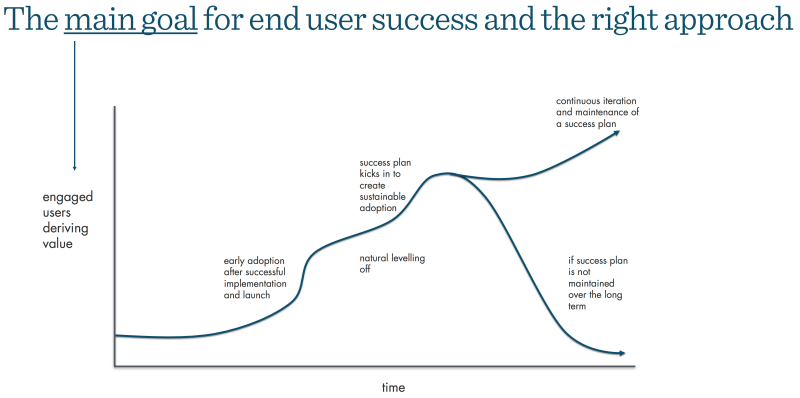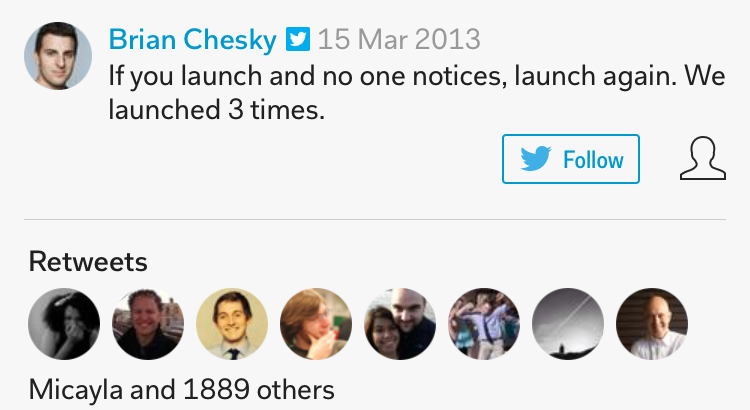The users of a technology platform inside an organisation are a peculiar, collective beast. They are very different to the masses of end users that are customers of a consumer product or service. They are also subject to very different forces than the free, open market subject’s consumers to. However, we can draw parallels and bring in comparisons and best practices from the consumer world and startups that launch successfully there. Launching a platform to enterprise users should be seen as no less important than launching on the open market.
In many cases the numbers of users will be vastly different. Inside the organisation the numbers will be on a much smaller scale for most but the very largest of organisations. Types of users also differ. For example, in the consumer world you have customers mixing with employees such as buyers and sellers on a shopping portal or travellers and hotel operators on a booking service, etc. In some cases enterprise platforms will be intended for use with end users or consumers but the platform will still have to be addressed and launched internally first which is what I focus on. Other platforms will be purely for internal use.
Also, their will be a difference between platforms intended for general use and collaboration or communication like intranets and those for specific purposes like HR or Sales software. The former will have the larger number of users generally. The latter will have a more focused niche of users with very specific motives.
Why emphasise the launch? Because its what you do in the first 90 days that matters. So if you are responsible for technology platforms inside your organisation or help those that are, hopefully these tips will be of use.
Its what you do in the first 90 days that matter most
I work as a customer success professional and have done for some time. In that capacity I’ve always been focused on the longer term strategic outlook for a customer’s use because I’ve always had an eye on the renewal date of the software. This generally tends to be at least a year down the line from the time the platform is first used. Most often these days though, its two to three years down the line with longer term contracts being signed.
In my job I advocate meaningful and strategic long-term considerations in the form of a good success plan. I’ve written about that in this primer on SlideShare. The launch phase is covered in the primer but only as part of the longer term approach. So I’m calling it out and expanding on it in this article specifically.
In some organisations, the customer success manager (CSM) is lucky to play a role in the launch of a platform and can effect outcomes positively. In other cases, launch is managed by an implementation manager and the outcomes of a good or bad launch have to be dealt with by the CSM when he or she takes over after the initial implementation phase. If the latter and the CSM is lucky, the hand off will be on the back of a successful launch.
The fact is also that if you don’t tackle the beginning stages properly, tackling the longer term is hugely more difficult, if not impossible. There are major challenges and opportunities with tackling adoption and engagement in the early stages:
- You only have one chance at making a good first impression. With so much competition for people’s attention, if you don’t make an impact at the beginning you may have lost before you’ve even properly started. These days in fact, not only do you have only one chance at making a first impression, it is severely limited in terms of the time it takes to make it. In many cases it’s decided in the first few seconds or minutes. This article makes the case brilliantly: First-Time Use: How To Reduce The Initial Friction Of App Usage
- Tackling the long term with a solid base of users that have had a favourable experience in the early stages is vastly easier than otherwise. It’s difficult to claw back good will and enthusiasm when a users first experience is lacklustre. Both from an organisational support as well as product capability point of view.
- Some may say that the enterprise is different and that these platforms, which might often be critical business systems, don’t need special attention. Besides this, a mandate to use them from the top, from senior execs, will take care of it. Mandating a platforms use is a strategy you could use in the enterprise and this might overcome some resistance and any competition in the early stages. However it is never guaranteed to work and should never be the only strategic lever.
- Getting a mass sign-up at the outset can almost eliminate uncertainty about a platform’s prospects because it effectively builds critical scale into the platform’s network from day one. This might be more relevant to the mass scale general use platform than the niche one in the enterprise but still important in either case. Users find a platform compelling when there are people on the platform to talk to and learn from and it provides some kind of evidence of early value. Every platform starts out empty, making these worries particularly acute. Building a network or network capability into a product is not easy (good evidence here: ‘Come for the tool, stay for the network’ is wrong) which makes launch activities all the more important.
In the chart below I’ve tried to position where the launch phase would sit in the context of a longer term success plan and its key goals. Achieving the main aim of engaging users and ensuring they derive value from their use of platforms is made immeasurable easier when you launch successfully.

Steps to follow for a successful launch
Based on some excellent experiences from startups and my own with launching dozens of enterprise platforms I have distilled it down to these steps (in no order of sequence or priority):
- Communications or marketing. Arguably the most important element of the launch, for startups at least. For the enterprise this should be simple and educational and could include marketing mails pre, during and post the launch phase. Crucially, it should build anticipation ahead of the launch. Think like Steve Jobs – the master marketer at building anticipation for new product launches. Some great ideas that could be transferred from the consumer world can be gleaned from this colossal post by Jeff Bullas: 23 Ways to Build Colossal Pre-Launch Product Buzz. Key as he suggested is building buzz – just make sure the actual reveal is not a let down if you do. Also, make sure to capture the main reason and benefits for using the platform both from an organisational as well as end user point of view.
- Supportive collaboration platform and community. The former only be necessary outside of the platform if the one you are launching doesn’t have any conversational or social features included. The purpose would be to build and amplify network effects – as covered in the article shared earlier, a crucial piece of the startups arsenal. Yet the point here is not to focus on the technology but rather the community. The community is what builds stickiness for the platform and that is a positive end if done well, not necessarily the means. The community is primarily where users can leverage their connections to help each other (solving learning issues or any other issue for that matter and for the platform, or more importantly, for the business) as well as share positive outcomes. This latter point is where you can scale success from an early stage in a positive feedback loop of success with the platform and business use cases.
- Webinars, training and offline events. You can do many things online to help scale your success efforts (I wrote an article about that here: Scaling your customer success efforts online – a guide) but nothing succeeds like physical interaction face to face. A launch event is a really good idea if you can manage it. Good training (online or off) should be one one of the basic boxes you tick off in this area but that really is just the start. I’ve seen the case far too many times where some training has been delivered (badly for the most part and only focused on features and functions) with the expectation that this is all that is needed and from there users can be left to their own devices. Coming back to the community part, it would be right to think about how you can keep the building of a community in mind when you carry out these activities. For example, offline events are the best way to start seeding an online community and webinars are also a great way to supplement and sustain it.
- In app intro’s and help. A lot of support in the early stage can be automated but however you do it, this is a critical time for it. If users get stuck and cannot find a solution to progress their use, it may well end up stalling further use altogether. Setting up a help desk (temporarily or ideally for the long term) that supplements a vendor’s own platform is a good idea. From a platform point of view, users should be able to easily log issues and requests for help that get handled at speed, possibly even in real time. Ideally the platform also offers walk through’s of different features or help buttons that explain a feature. Rich media like video or perhaps gifs should also be adopted.
- Senior exec sponsorship. In the startup world this might be enthusiastic customers that have been on a beta version of your product or service and are happy to speak for it. In the enterprise we speak of sponsorship which is a better way of framing the importance of using a platform than mandating it. However, if the platform is business critical from the get go, the task of mandating its use is made easier. Doing either well means explaining clearly why its important to use and why its critical to the business. When senior execs participate and show their involvement by leading from the front that helps greatly too. Sponsorship is a far more participatory approach but actual participation from senior business leaders is critical for success.
- Champions. In the startup world this would mean bloggers and other thought leaders and potential brand advocates. Giving them special attention, sneak peeks and information upfront is key before launch. In the organisation, having a network of super users that you identify far in advance of launch day is critical. They should be predisposed to using the platform and supporting other users. Pre-train them to a very high level. These users will be the early adopters and advocates that help scale your adoption and engagement efforts and pull other users along. You should have an entire program dedicated to identifying, building, growing and rewarding this cohort of users. Incentives to be and for being a member of the program would go a long way to making it successful.
What if you fail to launch successfully?
Then, as in Brian Chesky’s case (co-founder and CEO of Airbnb), don’t fret as you still have two more chances. At least that is, if you haven’t bungled the non communication aspects. This point only really applies if you launched and no one noticed. Maybe the timing was wrong and employees were too busy with other priorities or you simply bungled the communication and the messages didn’t resonate or make a big enough impact.
If on the other hand you have made the wrong choice of platform or the platform had terrible problems, bugs and issues, well then you have a harder task. Coming back from the latter is not going to be achieved simply by relaunching :)



Leave a reply to State of Customer Success 2018 – INNERVENTURES Cancel reply